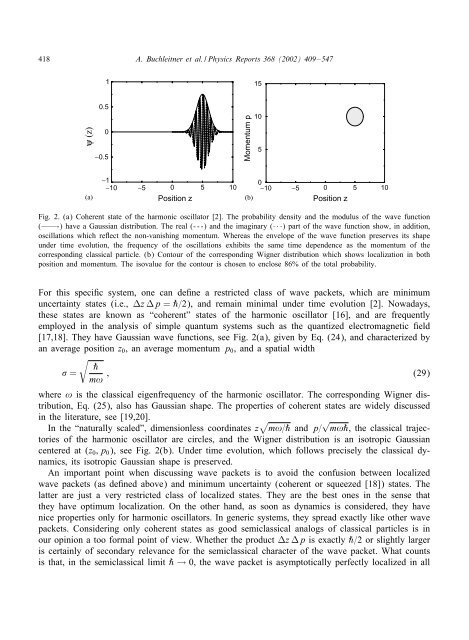Non-dispersive wave packets in periodically driven quantum systems
Non-dispersive wave packets in periodically driven quantum systems
Non-dispersive wave packets in periodically driven quantum systems
Create successful ePaper yourself
Turn your PDF publications into a flip-book with our unique Google optimized e-Paper software.
418 A. Buchleitner et al. / Physics Reports 368 (2002) 409–547<br />
ψ (z)<br />
(a)<br />
1<br />
0.5<br />
0<br />
−0.5<br />
−1<br />
−10 −5 0<br />
Position z<br />
5 10<br />
Momentum p<br />
(b)<br />
15<br />
10<br />
5<br />
0<br />
−10 −5 0<br />
Position z<br />
5 10<br />
Fig. 2. (a) Coherent state of the harmonic oscillator [2]. The probability density and the modulus of the <strong>wave</strong> function<br />
(——-) have a Gaussian distribution. The real (- - -) and the imag<strong>in</strong>ary (···) part of the <strong>wave</strong> function show, <strong>in</strong> addition,<br />
oscillations which re ect the non-vanish<strong>in</strong>g momentum. Whereas the envelope of the <strong>wave</strong> function preserves its shape<br />
under time evolution, the frequency of the oscillations exhibits the same time dependence as the momentum of the<br />
correspond<strong>in</strong>g classical particle. (b) Contour of the correspond<strong>in</strong>g Wigner distribution which shows localization <strong>in</strong> both<br />
position and momentum. The isovalue for the contour is chosen to enclose 86% of the total probability.<br />
For this speci c system, one can de ne a restricted class of <strong>wave</strong> <strong>packets</strong>, which are m<strong>in</strong>imum<br />
uncerta<strong>in</strong>ty states (i.e., z p = ˝=2), and rema<strong>in</strong> m<strong>in</strong>imal under time evolution [2]. Nowadays,<br />
these states are known as “coherent” states of the harmonic oscillator [16], and are frequently<br />
employed <strong>in</strong> the analysis of simple <strong>quantum</strong> <strong>systems</strong> such as the quantized electromagnetic eld<br />
[17,18]. They have Gaussian <strong>wave</strong> functions, see Fig. 2(a), given by Eq. (24), and characterized by<br />
an average position z0, an average momentum p0, and a spatial width<br />
<br />
˝<br />
= ; (29)<br />
m!<br />
where ! is the classical eigenfrequency of the harmonic oscillator. The correspond<strong>in</strong>g Wigner distribution,<br />
Eq. (25), also has Gaussian shape. The properties of coherent states are widely discussed<br />
<strong>in</strong> the literature, see [19,20].<br />
In the “naturally scaled”, dimensionless coord<strong>in</strong>ates z m!=˝ and p= √ m!˝, the classical trajectories<br />
of the harmonic oscillator are circles, and the Wigner distribution is an isotropic Gaussian<br />
centered at (z0;p0), see Fig. 2(b). Under time evolution, which follows precisely the classical dynamics,<br />
its isotropic Gaussian shape is preserved.<br />
An important po<strong>in</strong>t when discuss<strong>in</strong>g <strong>wave</strong> <strong>packets</strong> is to avoid the confusion between localized<br />
<strong>wave</strong> <strong>packets</strong> (as de ned above) and m<strong>in</strong>imum uncerta<strong>in</strong>ty (coherent or squeezed [18]) states. The<br />
latter are just a very restricted class of localized states. They are the best ones <strong>in</strong> the sense that<br />
they have optimum localization. On the other hand, as soon as dynamics is considered, they have<br />
nice properties only for harmonic oscillators. In generic <strong>systems</strong>, they spread exactly like other <strong>wave</strong><br />
<strong>packets</strong>. Consider<strong>in</strong>g only coherent states as good semiclassical analogs of classical particles is <strong>in</strong><br />
our op<strong>in</strong>ion a too formal po<strong>in</strong>t of view. Whether the product z p is exactly ˝=2 or slightly larger<br />
is certa<strong>in</strong>ly of secondary relevance for the semiclassical character of the <strong>wave</strong> packet. What counts<br />
is that, <strong>in</strong> the semiclassical limit ˝ → 0, the <strong>wave</strong> packet is asymptotically perfectly localized <strong>in</strong> all











